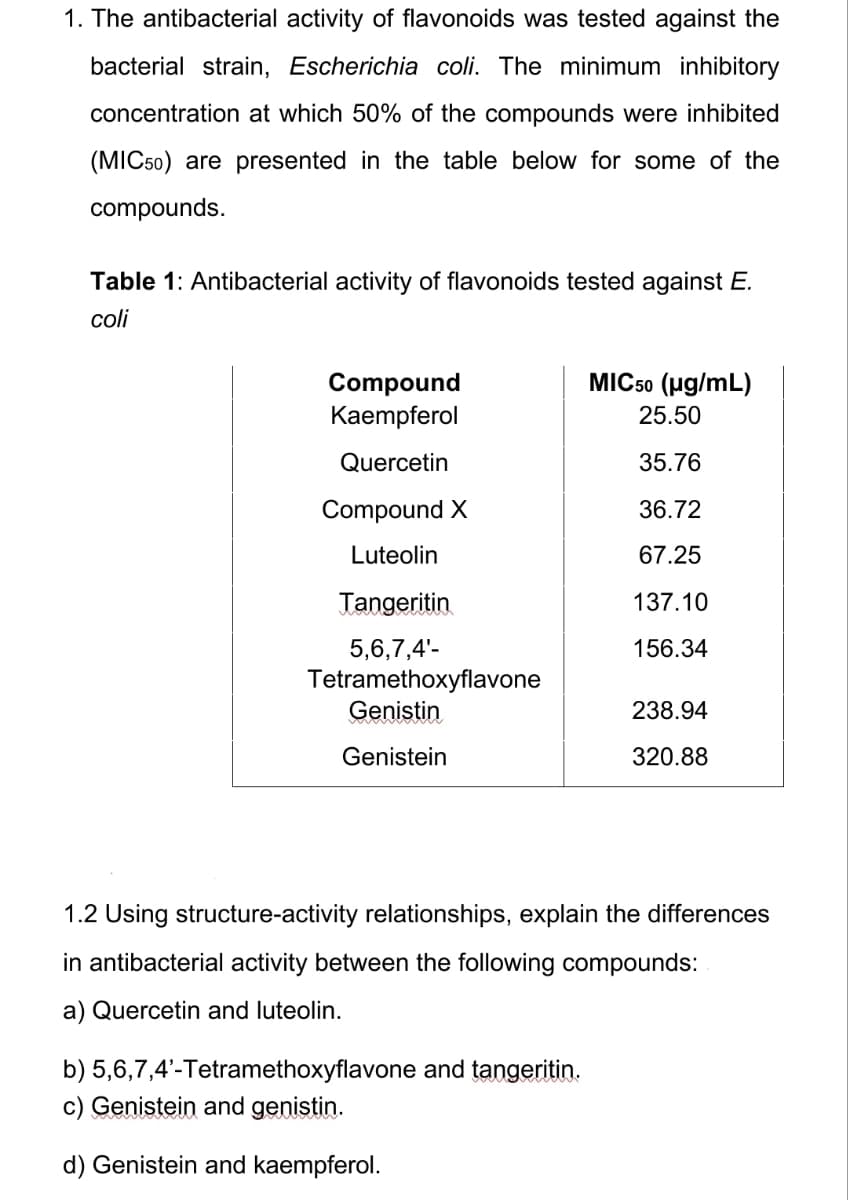1. The antibacterial activity of flavonoids was tested against the bacterial strain, Escherichia coli. The minimum inhibitory concentration at which 50% of the compounds were inhibited (MIC50) are presented in the table below for some of the compounds. Table 1: Antibacterial activity of flavonoids tested against E. coli Compound Kaempferol Quercetin Compound X Luteolin Tangeritin 5,6,7,4'- Tetramethoxyflavone Genistin Genistein b) 5,6,7,4'-Tetramethoxyflavone and tangeritin. c) Genistein and genistin. MIC50 (µg/mL) 25.50 35.76 36.72 67.25 137.10 156.34 1.2 Using structure-activity relationships, explain the differences in antibacterial activity between the following compounds: a) Quercetin and luteolin. Genistein and kaempferol. 238.94 320.88
1. The antibacterial activity of flavonoids was tested against the bacterial strain, Escherichia coli. The minimum inhibitory concentration at which 50% of the compounds were inhibited (MIC50) are presented in the table below for some of the compounds. Table 1: Antibacterial activity of flavonoids tested against E. coli Compound Kaempferol Quercetin Compound X Luteolin Tangeritin 5,6,7,4'- Tetramethoxyflavone Genistin Genistein b) 5,6,7,4'-Tetramethoxyflavone and tangeritin. c) Genistein and genistin. MIC50 (µg/mL) 25.50 35.76 36.72 67.25 137.10 156.34 1.2 Using structure-activity relationships, explain the differences in antibacterial activity between the following compounds: a) Quercetin and luteolin. Genistein and kaempferol. 238.94 320.88
Chapter16: Adult And Pediatric Dosages Based On Body Surface Area
Section: Chapter Questions
Problem 7.1P
Related questions
Concept explainers
Gene Interactions
When the expression of a single trait is influenced by two or more different non-allelic genes, it is termed as genetic interaction. According to Mendel's law of inheritance, each gene functions in its own way and does not depend on the function of another gene, i.e., a single gene controls each of seven characteristics considered, but the complex contribution of many different genes determine many traits of an organism.
Gene Expression
Gene expression is a process by which the instructions present in deoxyribonucleic acid (DNA) are converted into useful molecules such as proteins, and functional messenger ribonucleic (mRNA) molecules in the case of non-protein-coding genes.
Topic Video
Question

Transcribed Image Text:1. The antibacterial activity of flavonoids was tested against the
bacterial strain, Escherichia coli. The minimum inhibitory
concentration at which 50% of the compounds were inhibited
(MIC50) are presented in the table below for some of the
compounds.
Table 1: Antibacterial activity of flavonoids tested against E.
coli
Compound
Kaempferol
Quercetin
Compound X
Luteolin
Tangeritin
5,6,7,4'-
Tetramethoxyflavone
Genistin
Genistein
MIC50 (µg/mL)
25.50
35.76
36.72
67.25
137.10
156.34
b)
5,6,7,4'-Tetramethoxyflavone and tangeritin.
c) Genistein and genistin.
d) Genistein and kaempferol.
238.94
320.88
1.2 Using structure-activity relationships, explain the differences
in antibacterial activity between the following compounds:
a) Quercetin and luteolin.
Expert Solution
This question has been solved!
Explore an expertly crafted, step-by-step solution for a thorough understanding of key concepts.
Step by step
Solved in 3 steps

Knowledge Booster
Learn more about
Need a deep-dive on the concept behind this application? Look no further. Learn more about this topic, biology and related others by exploring similar questions and additional content below.Recommended textbooks for you

